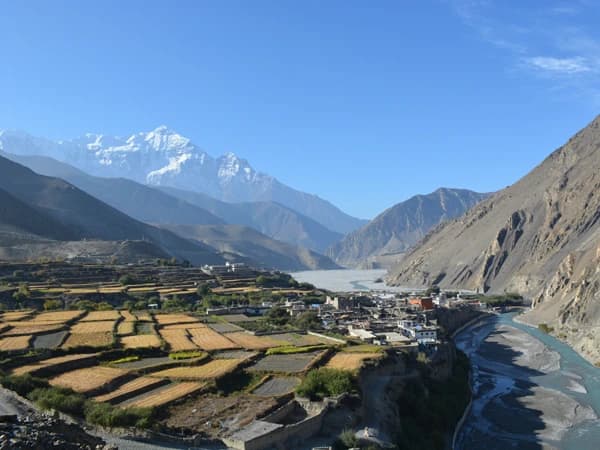Weather & Climate
Annapurna Region Trekking is suited in Low elevation to high land. Thus, there are diverse sorts of climate in this region most blustery territory Lumle, rain shadow zone Mustang (2,535 m to 4,000 m), and Highest pinnacle Annapurna I ( 8,091 m) is suited in this area. So the climate is extremely extraordinary in this part of Nepal.
For the trekking view, the vast majority of the trails are open nearly year and Highland trekking isn't recommended during the winter season because of the cold.
Best time to visit Annapurna region
Mid-September to mid-December :
This is the most well-known Trekking season in Annapurna Region. In light of the ongoing storm, everything along the trekking area is refreshed, perfect, and lively. Views are typically clear and the climate is commonly warm. Evening time temperatures dip under solidifying still, in any case, the night skies are regularly amazingly clear. This is the busiest period on the Annapurna Region Trekking.
March to May
In March, the rhododendrons begin blooming, which carries slopes buzzing with flaring hues. In view of the warming climate, this is the second most mainstream trekking season in the Annapurna region. The vast majority of the snow has disseminated, leaving completely clear skies. There is frequently an unusual murkiness that can be seen from the lower elevations between May. As the storm time frameworks towards the end of May, the days end up more sultry and increasingly humid, which makes trekking at a lower elevation very difficult.
Trekking in Annapurna region in Off-season
Mid-December to February
This is the coldest period in the Annapurna Region. Day time temperature will be cold and evening time temperature get well beneath solidifying. The tradeoff is that the trails are considerably less occupied. Thorung La Pass, Annapurna Base camp is frequently obstructed with snow and might be shut days on end. Except if the snow squares most trails, tea houses still stay open during this period. However, you can always go on other short trekking courses are open like Ghorepani Poonhill trekking, Panchase trekking.
June to mid-September
This is the rainstorm time. Despite the fact that there are accounts of heavy deluges, mudslides, and crowds of parasites, this is once in a while the case on the Annapurna Circuit, specific the northern area. While the south segment of the Annapurna Circuit close to Pokhara gets a great deal of rain, the northern parts regularly get under 10% because of its area inside a rain shadow. Trekking in the rainstorm time frame is that a large number of the vegetation species blossoms between this period, making the trek extraordinarily excellent.
Chances of mountain sickness while trekking in Annapurna Region during off-season
AMS, for the most part, known as Acute Mountain Sickness is a major issue while trekking in high Himalayas of Nepal. High height ailment implies the impact of height on the individuals who climb and quickly rises over 3000/10,000 ft. The case of AMS is based upon the rise, the rate of climb, and individual powerlessness.
Numerous individuals will encounter mellow AMS amid the acclimatization procedure, and this is in reality progressively normal in fit youngsters since they are bound to attempt a quick move by hustling up the mountain like some indestructible superhuman!
When in doubt, it is far more secure and increasingly pleasant to dodge elevation affliction by arranging a reasonable agenda that takes into consideration steady acclimatization to height as you climb, however, you could keep running down as quick as you prefer.
Views?
Annapurna Circuit Trek is frequently delegated as a standout amongst the best treks on the planet. Some even call it "the sacred chalice of trekking".
This great trek of around three weeks spins around the Annapurna massif in a counter-clockwise heading. It takes you to rich waterway valleys, captivating Himalayan towns possessed by Nepal's ethnic individuals, an exciting high pass, best perspectives to take a gander at the Himalayas, hot springs and to the Land past the Himalayas.
Tips for a successful trip in Annapurna region during the Off-season
Do you want to go to the Himalayas? Do you cherish trekking?
If sure then, the off-season time for trekking ought not to discourage you to go to the Himalayas. This time sees generally fewer voyagers on the way to your goal. Fewer voyagers imply that you can go on a trek and appreciate the view and the high Himalayas just by you and your kindred trekkers.
On the off chance that you are going amid the storm season, you ought to dependably have an overcoat convenient. This will assist you with beating the deluge in the event that it occurs amid your trek. It is constantly fitting for a decent combination of waterproof boots too since you will walk the whole distance to your trek goal and back.
Following are the rundown of things which you ought to carry with you close by your ordinary trekking embellishments:
- Raincoat and/or umbrella
- Waterproof boots
- Waterproof outer clothing
- Small towel
- Waterproof backpack or waterproof backpack cover,






